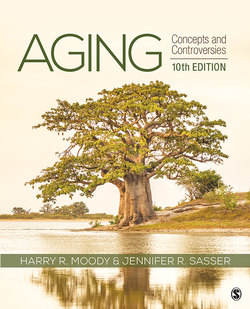Читать книгу Aging - Harry R. Moody - Страница 97
На сайте Литреса книга снята с продажи.
The Rectangular Curve
ОглавлениеSurvival curves for animals show a similar pattern of rectangularization with domestication or better care. Old age in wild animals is very rare, as it probably was for prehistoric man living in a dangerous environment. In uncivilized environments, accidental deaths and violent deaths account for a greater proportion of deaths than the biologically determined life-span limit. For the great majority of wild animal species, there is a very high neonatal mortality, followed by an adult mortality rate that is almost as high and is nearly independent of age. In such environments, death occurs mostly as a result of accidents and attacks by predators. One day is about as dangerous as the next.
By contrast, animals in captivity begin to show survival curves much more rectangular in shape. Such animals are removed from most threats by accident or predator, and for them the second term of the equation, that of the species’ life span, begins to dominate. Figure 2 shows theoretical calculations of this phenomenon after Sacher (1977). Such rectangularization has been documented for many animals, including dogs, horses, birds, voles, rats, and flies….
Figure 3 is drawn from the data Shock developed in 1960, and it is modified only slightly from what has been called “the most frequently shown data in the field of gerontology.” The data show that many important physiological functions decline with age, and the decline is quite close to being a straight line. It is important to emphasize that these data were obtained from healthy human subjects in whom no disease could be identified that was related to the function being measured. Thus, the observed decline does not depend on disease.
Figure 3 is a major oversimplification of complex data…. The lines are not actually as straight as portrayed, and some of the data have been contested. The point is that a considerable body of research supports a gradual, nearly linear decrease in organ function with age.
Description
Figure 2 Theoretical Survival Curves for an Animal Become Progressively More Rectangular as the Environment Progresses From Wild to Domestic
Source: Redrawn from G. A. Sacher, “Life Table Modification and Life Prolongation,” in C. E. Finch and L. Hayflick, eds., Handbook of Aging, Van Nostrand Reinhold, 1977.
Description
Figure 3 The Linear Decline of Organ Function With Age
Source: U.S. Bureau of Health Statistics. Redrawn from N. Shock, “Discussion on Mortality and Measurement of Aging,” in B. L. Strehler, S. D. Ebert, H. B. Glass, and N. W. Shock, eds., The Biology of Aging: A Symposium. Copyright © 1960, American Institute of Biological Sciences.
Normal, healthy organisms maintain an excess organ reserve beyond immediate functional needs. We have four to ten times as much reserve function as we need in the resting state. The heart during exercise can increase its output sixfold or more. The kidneys can still excrete waste products adequately if five-sixths of the functional units, the nephrons, are destroyed. Surgeons can remove one entire lung, and sometimes part of the second, and still have an operative success. Three-fourths of the liver can be removed, under some circumstances, and life is still maintained.
However, the mean level of reserve in many of our organs declines as we grow older. We seldom notice this gradual loss of our organ reserve. Only in the circumstances of exceptional stress do we need all that excess function anyway. Shock and others suggest that the decline may be plotted as a straight line.
